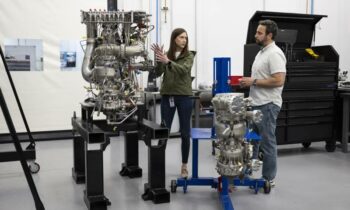Giant in the computer and AI space develops a device that uses “Heron” chips that use subatomic particles rather than ones and zeros.
On Monday, IBM, a leader in artificial intelligence and computer technology, unveiled a new quantum computing chip and machine. According to the company, these could be the foundation for much larger and faster systems than those made with traditional silicon-based computing.
IBM unveiled its Quantum System Two, which employs three cryogenically cooled “Heron” chips. This announcement coincides with the competition among tech rivals, such as Microsoft, Alphabet’s Google, China’s Baidu, and others, to create devices that utilize quantum bits, which are subatomic particles that, in contrast to the ones or zeros of conventional computing, can be in a state of “superposition” representing both one and zero simultaneously.
An image of a brain traveling over a network as pixelated data
By 2033, IBM claims to have created a new method of joining chips within machines and subsequently machines to machines. This method, when paired with an innovative error-correction code, could result in quantum machines. The business says it intends to integrate the new chip into its Watsonx enterprise AI platform.
IBM’s director of research, Dario Gil, stated in a statement that “we are firmly within the era in which quantum computers are being used as a tool to explore new frontiers of science.”
Gil clarified to CBS 60 Minutes on Sunday that quantum computing could make it possible to solve issues in physics, chemistry, engineering, and medicine in a matter of minutes as opposed to millions of years, if at all, for today’s supercomputers.
“The beauty of it,” he remarked, “is that not even a million or a billion of those supercomputers connected together could do the calculations of these future machines”.
According to Serpil Erzurum, chief research officer at Cleveland Clinic in Ohio, IBM has installed one of the new machines there. According to Erzurum, the technology may one day be used to model the behavior of proteins and the shapes they adopt based on their functions.
“I need to understand the shape it’s in when it’s doing an interaction or a function that I don’t want it to do for that patient,” says Erzurum. “Cancer, autoimmunity – it’s a problem. We are limited completely by the computational ability to look at the structure in real time for any, even one, molecule.”



